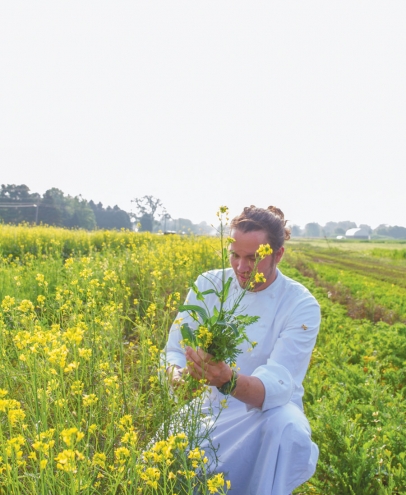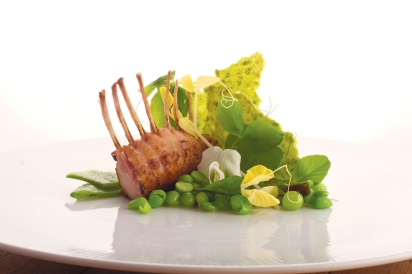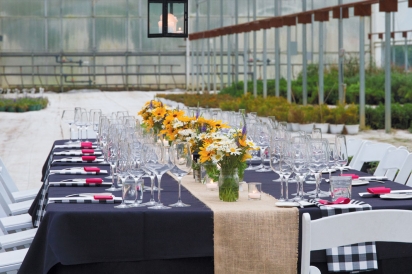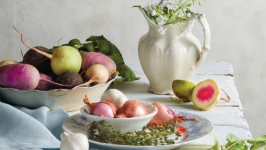A Philosophy of Vegetables with Chef Jamie Simpson
The synergy and creativity between Chef Jamie Simpson and The Chef’s Garden at The Culinary Vegetable Institute
Stepping into The Culinary Vegetable Institute (CVI) at The Chef’s Garden in Milan, Ohio, is like entering a sanctuary. Tucked into the woods, the high, vaulted ceiling and walls made of wild cherry, black walnut, tulip poplar, oak and ash envelop you. The world-class kitchen where executive chef and chef liaison Jamie Simpson spends his days welcomes you like a Mother’s hearth—the aroma of pots full of vegetables cooking on the stove and Mozart playing in the background. After driving two hours from Columbus through rural Ohio, I feel both at home and transported to a most magical place.
Birth of a Vegetable Institute
Like the philosophers of the past, Bob Jones Sr. and his two sons, Lee and Bob Jr., and their iconic farm, The Chef’s Garden, have insights into the Earth, transforming a world of vegetables, flowers and herbs into an extraordinary product and experience. A long-standing cultural institution with a history of growing beautiful vegetables “slowly and gently in full accord with nature,” The Chef’s Garden is guided by the relationship between the chef and the farmer. What chefs want, the farmers at The Chef’s Garden will grow. What the farmers at The Chef’s Garden grow, chefs really, really want. This symbiotic relationship has supported some of the most famous chefs over the past 30 years. It’s no mystery how or why what is grown at The Chef’s Garden is as sought after as it is and expedited all over the world. The farmers love the Earth. The Earth loves the farmers. The result of this amour is a heritage and a legacy steering the consciousness of the culinary world towards its next evolution.
Fourteen years ago the farmers at The Chef’s Garden wanted to create a relaxing, intimate environment for chefs to stay and experiment with what the farm was growing each year. They envisioned a space where “chefs could get back to what they love with this bountiful playground of the most exotic, sexy, healthy and chemical-free vegetables they could imagine,” says Lee. Thus the birth of CVI.
Today CVI is a laboratory and performance space for both chef and guest alike. If you love farmers and the good food they grow, you must taste what is most revered and subtle about The Chef’s Garden and its history by visiting CVI. You can attend a specially themed dinner or cooking class, host a private event and so much more at CVI year round (see sidebar on page 34 and our story on page 28 to plan your visit).
“The thing that brings chefs to this world is the creativity,” says Lee. “The better the chefs are, the less they get to do what they love. I talk to chefs that don’t even get to cook anymore. They have to be managers. They have to be marketers. They have to have a leg in HR. They have to be motivators and leaders. They don’t get to cook.”
Farmer Lee, director Marcie Barker and the team at CVI effectively hold the door open for the chefs to come home and cook, reinvigorating their relationship with the Earth. Over the years, an advisory board of luminary chefs like Daniel Boulud, Alain Ducasse, Charlie Trotter, Thomas Keller and Lidia Bastianich have collaborated with Chef’s Garden to build CVI to what it is today. There have been a handful of chefs who have stood at the helm of CVI, acting as the leader in the kitchen, advancing flavor, technique and craft for events, cooking classes, corporate meetings and experiments with visiting expert chefs from around the world. Yet in the past two years the young chef Jamie has come to the stage as the next evolution of this synergy between chef and farmer at CVI. He is the first to fulfill the role of executive chef and chef liaison to the farm. And he brings with him a je ne sais quoi.
Renaissance Man
“I look at every moment in life as an opportunity to create something compelling,” says Jamie. Intelligent, playful, creative and generous in heart and thought, his food is visually stunning, sometimes whimsical, deft and delicious. Originally from Charleston, South Carolina, Jamie has artist blood in him, having studied the visual arts and played in a rock and roll band before turning to a culinary life. After climbing the restaurant ranks, he landed at the Charleston Grill and worked under Chef Michelle Weaver for almost half a decade. During that time and after his stint at Charleston Grill he staged at restaurants around the world. It was among the Michelin Star kitchens where he saw boxes shipped from Huron, Ohio in their walk-in refrigerators that he discovered the true reach of The Chef’s Gardens’ vegetables.
With vegetables having a renaissance in this country, CVI has found its renaissance man in Jamie. Thought leaders like Michael Pollan declare: “Eat food. Not too much. Mostly plants,” heralding the demand for organic and locally grown produce. People want food that is vital, colorful and nourishing. The word “vegetable” comes from the Latin vegetabilis meaning “to be enlivening, quickening,” and spending time in the kitchen with Jamie, or savoring one of his dishes, will feel like exactly that—something in you will come alive.
A Walk in The Garden
The warmth of one of The Chef’s Garden’s colossal greenhouses embraces Jamie and me. We stand underneath a long tunnel of rising fava bean plants, their little white and violet-colored flowers popping off the vines.
“Can I eat those?” I ask, pointing to the flowers.
“Yes,” says Jamie, and I do and I am most happy I did. The flower is peppery and earthy and makes me feel the same.
Walking through muddy fields and gardens with Jamie, he hands me one gorgeous plant after another—deep green Ice Spinach, delicate cilantro flowers, fragrant begonia petals—stalk, leaf, stem, seed. To touch, hold, smell and eat these plants is transformative. They’re plump and full of light from the moon, sun and stars and minerals from the Earth. Their colors radiate with life force. Jamie is at home among this Eden. He walks the gardens every morning, savoring the flavor and fragrance of what is growing, talking with the farmers and getting inspired for the next dish at CVI.
His boyhood relationship with vegetables was defined by a “standard suburban childhood” of canned and fast foods, acknowledging his mother did the best she could with what she had. “The food was nowhere near as important as the simple act of gathering and talking,” he says. Nature was his constant, and now informs his aesthetic and approach to cooking.
“Before I ever came here, I spent my free time in the woods. From building forts as a child to harvesting and selling mushrooms as an adult, nature has been with me my entire life,” he says. “Nature is my sanctuary. I take it very seriously.”
Jamie reveals classic writers like Ralph Waldo Emerson and Henry David Thoreau, and the contemporary visual artist Andy Goldsworthy, as his inspiration. “Goldsworthy, for me, is the most original and inspiring living artist. His collaboration with nature is without a doubt genius. The concepts are so simple yet daunting. His work requires many, many hours of patience and an understanding of nature and how it responds to organization. He brings a new kind of life to something that already exists.”
It’s this artistic view of nature and food that keeps Jamie hunting for the next dish, the next flavor at The Chef’s Garden.
Back in the kitchen at CVI, Dario Torres and Mariel Carrasco Garay are cooking. Jamie’s team and “the two most important people not only in my work but in my life,” Dario and Mariel are from Puerto Rico and exude tremendous skill and a quiet joy. Jamie leads them like they’re family. They’re preparing for a four-course dinner for 10-plus guests that night, as well as two big dinners over the weekend. Most of what Jamie uses in the kitchen comes from The Chef’s Garden. He also sources locally from farms like Speckled Hen Farm and Snowville Creamery.
That night when I sit down for a meal made by Jamie, it’s not the hearty third course or the sweetly crafted carrot dessert that wins me. It’s the second course—a walk in the garden—featuring a base of creamy carrot purée supporting slivers of tiny vegetables packed with zest from the farm like baby turnip, radish, pea and microgreen. It’s the simplicity and fullness of the plate. Jamie’s walk through Eden evidenced in one moment, one taste.
Jamie makes eating your vegetables fun again.
Questions of Sustainability
Jamie sees the future of food in—yes—vegetables. “Not just carrot roots and sweet potatoes but the whole plant’s top and all. Every part of most plants is edible and more often than not, equally delicious to the part that we see in grocery stores today. This is real whole food.”
Lee agrees. “With vegetables and plants and herbs there are thousands yet to be explored, and this is the direction we need to go—we need to be more of a plant-driven diet and consumption in the United States.”
Jamie is also strategizing ways to eliminate food waste on the farm. “It is no secret that the food system in America is incredibly wasteful. Every stage of production and distribution in this country, from a field to your garbage can, results in approximately 40% total waste. That means if America grows 10 pounds of carrots, only six pounds will ever be consumed and four pounds will be thrown away. I find this troubling.”
Questions about nutritional values in commodity crops and health, local preservation, the use of local resources and the “steady increase of hybridized heirloom varieties” are on Jamie’s mind, too. Yet the complexity and challenge of all that is coming our way light him up, and his ability to be present in the moment suggests an enlightened perspective.
He’s a maverick, he’s an innovator and yet he makes you feel comfortable in one of the world’s most revered kitchens. The philosophy that he and the Joneses embody is down-to-earth. It’s an ethos grounded in the Earth and its vegetables. It’s rooted in what is most beautiful, pure and true about being human and eating together, and how when beauty is the goal, culture is the result. It’s an understanding of the human spirit and its bond with nature.
I do hope you visit CVI someday. You, like the vegetables, will be made brighter because of it.
The Culinary Vegetable Institute
12304 Mudbrook Rd., Milan, Ohio, 44846
Phone: 419-499-7500
Email: info@culinaryvegetableinstitute.com
Plan Your Visit
The Culinary Vegetable Institute (CVI) offers a range of events for you to enjoy from vegetable showcase dinners and earth-to-table dinners to professional workshops and monthly cooking classes. Private events include weddings, private parties, luxury farm stays, private cooking classes, team building retreats and corporate meetings and conferences. See our story on page 28 to plan your trip, and visit culinaryvegetableinstitute.com for a full listing of their events for 2016.








